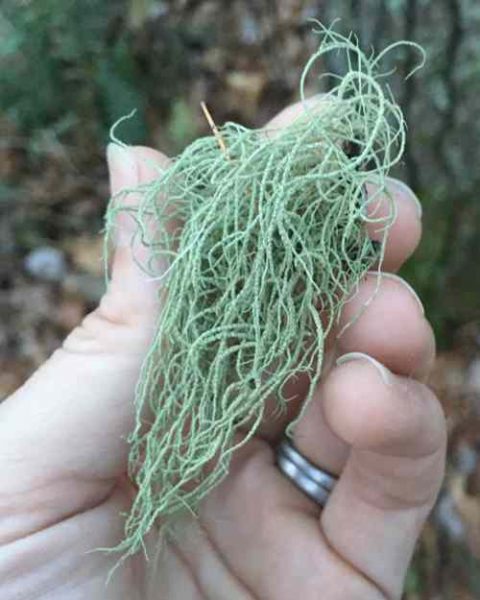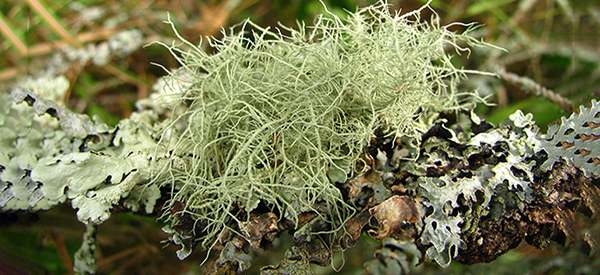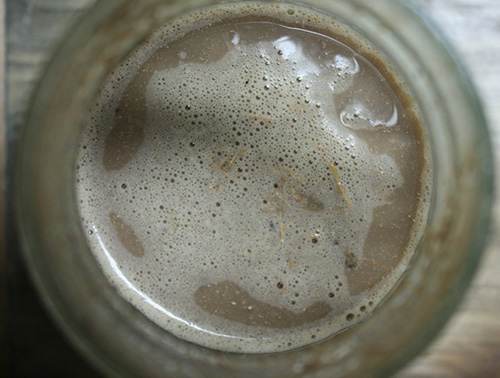There has been plenty of concern in recent years with the overuse of antibiotics, and the risks that overusing them can bring, even to a normally healthy person. While prescription antibiotics certainly have their place and benefit, overusing them, or using them inappropriately, can contribute in creating a resistance to the medication that was developed to heal. Another concern is all the uncomfortable and serious side effects that can come with taking antibiotics, such as nausea, rashes, sensitivity to the sun, and potentially fatal c. diff colitis.
It’s no surprise then, that more and more people are turning to natural remedies and antibiotics, such as usnea. You might be wondering if natural and homegrown antibiotics could cause side effects or be harmful to certain people? Sure, just like prescription antibiotics, there can be side effects. However, unlike more commonly known prescription antibiotics, usnea can be completely natural without unhealthy chemicals…and you might even be able to find it right in your own backyard. You may also want to check if these extremely powerful natural antibiotics that are little known to mankind grow around your house.
What is Usnea?
Usnea is a fairly common and intriguing lichen found in many forests and woods across the world. A lichen is defined by Merriam-Webster as: “any numerous complex plantlike organisms made up of an alga or a cyanobacterium and a fungus growing in symbiotic association on a solid surface (such as on a rock or the bark of trees).” The usnea lichen, which has a body with a netted hair-like texture, is developed through a mutual relationship between fungus and algae.
While there are several types of species of the usnea lichen, the one with the highest degree of medicinal value is often referred to as “Old Man’s Beard”, due to its appearance. Often found on trees, it can easily be identified by lightly pulling the main branch of the lichen apart. If it’s usnea, the green outside layer will break, exposing a stretchy white band substance found inside, which should remain intact. However, due to this species being ultra-sensitive to polluted air, it’s rarely found within city limits.
Possible Medicinal Value and Uses of Usnea
Usnea has been used for medicinal purposes since ancient times by Egyptian, Greek, and Chinese healers. This is not a new plant, nor a recent or temporary fad. It has been around for a very long time for use in healing people with certain ailments. The outer portion of the lichen, referred to as the cortex, holds the antibiotic composites, and the inner part (the thallus) contains a substance that stimulates the immune system.
Common ailments and conditions that are thought to benefit from the application of usnea, include the following:
- Fever
- Inflammation
- Weight loss
- Yeast infections
Some people with HPV (human papilloma virus) have also found some benefit in using a form of usnea. It’s suggested that a person apply a product containing usnic acid (found in usnea) and zinc sulfate to the vaginal area prior to and after the surgical removal of HPV lesions. By doing so, it could help speed up the healing process and diminish the chances of recurrence of the infection.
Although it’s been used globally since ancient days, for various purposes, usnea has eluded various herbal traditions that solely focused on vascular plants. However, the usnic acid is found to interrupt the cellular system of Gram-positive bacteria, such as Staphylococcus and Streptococcus, while leaving the necessary natural microbiota intact.
It is a particularly formidable medicinal tool for inflammation and dampness often associated with respiratory and urinary tract infections. Applied topically, usnea can also be effective in fighting against MRSA, and fungal infections such as candida.
Used as a wound dressing, usnea could be a wonderful remedy for infected wounds, such as cellulitis. The drying and cooling attributes of usnea help to reduce heat and redness stemming from the infection. Due to the natural anti-microbial properties found in the lichen, it is often applied directly to an open wound to fight off infection. It can either be mixed with water to form a mixture to be applied, or used as a powder after it’s been dried.
A spray could also be used to apply on areas where fungus might be lingering, such as the feet, either between the toes on in the nails.
Finding and Developing Usnea as an Antibiotic
Usnea can be applied either externally, or internally. It can be developed into various forms, such as the following:
- cough lozenges
- a tincture or extract

- mouthwash to gargle with, by mixing water with a usnea tincture
- a salve for wound dressing, to apply externally
Some of the above forms can be found in a health store. But, you can also make your own. And, a walk through the woods might be all you need to find the main ingredient. When looking for usnea lichen to make your own remedies, you can often find it in the woods, either on trees, or the ground after falling from the trees. Look for hair-like growths, similar to an overgrown beard. If you find it, place it on cotton or paper until you can get it home. From there, you will have diverse options in developing a viable antibiotic and treatment to use for the ailments and conditions mentioned earlier.
Usnic acid isn’t soluble in water. So, it’s best to extract it in alcohol, oil, or heat. Depending on which form you are seeking to create, or use, the extraction method can differ. For example, when making a tincture or extract, place the usnea into a jar, then cover it with vodka. Let this mix sit for several months, then strain it into a dropper bottle.
Consulting an herbalist would be beneficial if you have any doubt or questions on how to make the proper form, how to apply it, or where to find it.
You may also like:
 Similar to Morphine: The Best Natural Painkiller that Grows in Your Backyard
Similar to Morphine: The Best Natural Painkiller that Grows in Your Backyard
Forget About Food Stores. Here’s How to Build a 5 Year Food Stockpile (Video)
Potassium Permanganate: Why You Need It in Your Survival Kit?













Thanks for this article. This antibiotic is very useful for animals and is essential for the farm. Also, a couple drops of this extract in tea for humans can ward off all illnesses in the winter, taken at the first sign of a scratchy throat.
which commercial brand would you recommend?
I’ve been using “eclectic” institute from The Vitamin Shoppe on line with really good results!
?
Could this be good to apply or soak in for Bumblefoot in chickens?
Could this be made into a tincture?
Helpful Info
send me my free silver coin as promised or is this just another one of our internet scams ?
Do you have anything better to do with your life, than to beg from freebies!
Is Usnea the same as Spanish Moss that hang from many of the Oak Trees here in Florida?
No, looking up spanish moss it’s binomial name is Tillandsia usneoides. Usnea main genus is usnea with several species such as calfornica, eratina, longissima which would make the binomial name Usnea longissima for example. They come from different families and genera. The Spanish moss local to you may have useful qualities, with a little research into local foraging books, a local herb shop, or if you can find a local herbalist, they may be able to tell you if it’s useful for anything.
Thank you for your reply. Your info was useful and I did look up Tillandsia usneoides and found useful information. Thanks
When gathering Spanish moss, be careful! They usually harbour chiggers! The only thing I’ve ever heard it used for is stuffing for bedding, ( after removing chiggers). It doesn’t mean it has no other use, just I’ve not heard of one.
no. Spanish moss is completely different
Also known as CONDY’S CRYSTALS.Can be used as a soak for athletes foot diluted of course very cheap at Pharmacies…..
Tillandsia usneoides (more commonly known as spanish moss) is a perennial plant with many therapeutic uses as a dietary supplement and herbal remedy for fever, chills, and
Sorry I meant a thumbs up. I wanted to know the same
Here in the deserts of New Mexico and Arizona all lichens on rocks were used a a poltice on wounds. It is said to be quite effective. Bind directly on on the wound with a cloth and change the dressing in 24 hours. This was done on both old and fresh wounds to promote healing if infected and to avoid infection in the first place. If a wound was infected it was scraped to remove any puss and rotted flesh, then a wash of steeped lichen water wash used and if severe a poltice was used.
Sometimes a wash of steeped oak leaves and bark was also used to cleans a wound. Oaks are not so common in deserts and lichens were more commonly found.
?
I know what milkweed looks like however I have never seen it with yellow flowers. Is this a different plant? I know milkweed has pods which I have read are edible. so is this the same plant?
The genus Asclepius, which is what milkweed belongs to, has a lot of different species. Some have pink, yellow, orange, or white flowers. Some are used medicinally some are not. Here is a good article on whether Asclepius are edible or not http://www.eattheweeds.com/asclepias-some-like-it-hot-some-like-it-cold-2/
Milk weed, can come in a variety of colors. I believe some are hybridized, but are available in reds, oranges, yellows and white and frequently sold as “Butterfly plant” or “Butterfly weed”. However, I do not know if the hybridization affects its homeopathic benefits.
Dolores: I like it, but Arizona varieties are not eatable. We used to pick the pods off swamp milkweed (in PA and Ohio), boil them, and use them like cream cheese. Good eating. niio
How much of this plant do I need to make a pint jar of tincture
Just like Doxy . . .? Usnea may have topical efficacy as an anti fungal, and selective efficacy on bacteria, but to say it is just like Doxycycline, which has efficacy on bubonic plague and smallpox may be irresponsible. Are you also suggesting ingesting Usnea, as opposed to being a topical treatment? Watch out! Safety and efficacy.
All of my reading on using Usnea has been for internal use, and is considered safe. But it is not common everywhere, nor is it easy to extract the medicinal prperties. Anyone interested can easily look up articles written by herbalist on using this valuable lichen. Herbalist Christopher Hobbs and Robert Rogers have written books on using lichens and fungi medicinally. Rogers book also includes identifying them.
Doxycycline is very effective on Plague though has no benefit on Small Pox.
Is this plant what floridians call airplanes that grow in the trees?
My last question should have been the airplants that grow in trees in Florida not airplanes
Dont you love “auto-correct”! Lol
I would never compare an herb to a pharmaceutical. Just my thoughts. I feel like that’s misleading.
Until the chemical industries took off after WWII, ~90% of all pharmaceuticals were plants.
Aspirin? From willow bark. Morphine , poppys. Heck, even in the 2000s we are using a Yew extract to treat breast cancer. Herbs ARE pharmaceuticals.
Many pharmaceuticals are derived from the same plants…they just add more “crap” and charge more for them.
Esther: Medicine is based on plants and metals. Chemical meds are getting to the point they barely work, but the naturalis pharmacopolium eo works as well as it always has. There are books published where doctors use home remedies on family members. This is getting more common. People who do not understand how herbal remedies work often abuse them, so be patient is you do try anything. niio
You’re right! Natural herbs are so much better! Big Phama is a joke, taking many natural God given things, and destorting snd adding just enough to patent.
Borax for example, balances hormones,, balances ph, detoxes, and amazingly helps arthritis when taken daily with 400mg of magnesium… but when discovered in the 60’s it ended up being banned in several countries and marked toxic in all, I believe. 40 Mule team laundry detergent booster, is natural out of the ground like Epson Salts. I have been taking 1/4 tsp a day 4 days a week, I bathe in it, wash my hands with it, (softens skin), and if you look it up, so many more people are using it now!
I could go on about others, but research your self, and stop listening to the evil controllers.
By the way, Big Pharma use it in many things including eye drops.
It grows in mountain forests in Mexico, so it should be here, Arizona, as well. Also found this for all us desert rats 🙂
https://www.theforagerspath.com/educational-resources/plant-profiles/plant-profile-desert-barberry/
I found a supplier on ebay last year. Usnea Lichen /Old man Beard was extremely fresh. when I received the product, I rinsed and air dried. Bought mine in 2-1 gal bags, stuffed full. total was $30.00 for 2 gallons and free shipping.
How much of this plant do I need to make a tincture in a pint jar?
As with any herb usually half to 2/3 jar stuffed with herb then fill with 80+ proof alcohol to 1 inch head space for 4+ weeks. I usually let mine sit for minimum of 6.
When making a tincture from usnea, how long will it keep? Is there a point in which its efficacy declines?
Tha Bet (thabet) is considered as the house that owns the largest and most diverse online game store. There are all forms of sports betting, attractive card games, etc. with high winning rates. Including prizes up to 5 billion VND. Please visit Tha Bet to join
A lot of the reason antibiotic doesn’t work as well as what it used to is , if you eat factory farmed meat and dairy, you’re unknowingly eating antibiotics, due to the animals being jacked up with it, due to not getting enough fresh air, sunlight, exercise and standing around in their own feces.
does usnea help with malaria prevention/treatment? do you know of anything i can use that is natural that prevents malaria?